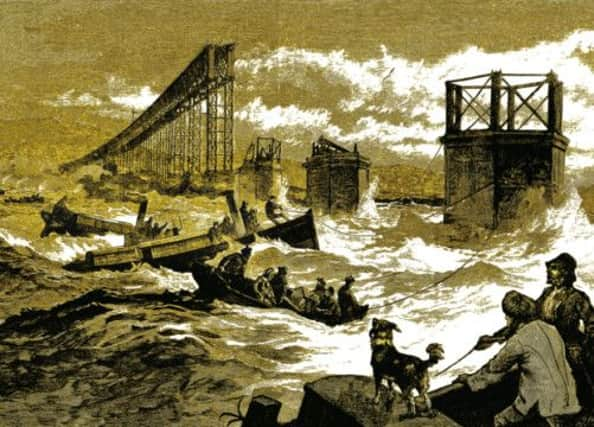Memorial sparks Tay Bridge deaths row


A total of 59 names will be engraved on rectangular granite plates to be unveiled at either end of the bridge next month to mark the 134th anniversary of the tragedy.
However, an author whose great-grandfather had been due to catch the ill-fated train which crashed into the Tay has claimed there were up to 85 on board. The train toppled off the two-mile bridge when the half-mile central section collapsed during a storm. The disaster led to major changes in bridge construction.
Advertisement
Hide AdAdvertisement
Hide AdThe official inquiry found the bridge had been “badly designed, badly constructed and badly maintained”.
The foundations for a memorial on Riverside Drive in Dundee have been laid by the Tay Rail Bridge Disaster Mem-orial Trust.
Secretary Ian Nimmo White said the 8ft high granite plates containing the names of the dead are due to be added next week, while a similar memorial will be erected in Wormit, at the southern end of the bridge. They will together cost £35,000.
But in his book Tay Bridge Disaster – The People’s Story, Fife-born Robin Lumley claimed there were far more casualties. He said many of them were children under five who had not needed tickets because they were travelling with their families.
Lumley, a record producer and former member of Phil Collins’ Brand X and David Bowie’s backing band Spiders from Mars, said some railway staff had travelled free and were also not counted.
In his book, Lumley described the incident on 28 December, 1879, as “the most catastrophic failure of a civil engineering structure in Britain”. However, the avid rail enthusiast said he was sure there were more than 59 victims – even if there were no death certificates to prove it.
His ancestor, Jamie Lee, had planned to return to his Dundee home on the train but was delayed by a late-running business meeting in Fife.
Lumley wrote: “In some other accounts of the Tay Bridge disaster, the death roll of passengers and crew on the 5.27pm from Burntisland has been quoted as 75 persons.
Advertisement
Hide AdAdvertisement
Hide Ad“It may be noted that in this version of the story, the number has been raised to a possible 85 victims.
“This is because research over the years has revealed another possible ten casualties,”
Lumley said: “In the research time of seven years, I diligently checked and rechecked all of the story and what I’ve written down I believe to be the truth.
“The memorials being erected are under the auspices of Ian Nimmo White. If that number of 59 victims is what he believes sincerely is a fact, then so be it. I must agree to differ.”
Lumley said only 46 bodies were found, one of them near Wick three months later, and he reckons 18 to 20 people could have been washed into the North Sea. He said these could have included two young girls travelling unescorted from London, for whom no death certificates were issued.
He said: “The non-issue of death certificates doesn’t mean they weren’t victims.”
But Nimmo White said Lumley had not proved the death toll was more than 59.
He said: “We don’t believe that 59 people died in the disaster. We know they did, we have their death certificates.
Advertisement
Hide AdAdvertisement
Hide Ad“In the 134 years since the tragedy, many theories and/or claims have been advanced for more victims, but to the best of the knowledge of the trust, nobody has come up with incontrovertible evidence to support their theories or claims, be they author, family member or other.
“It’s all about death certificates really. Do children under five really disappear as the result of a national tragedy such as this without a surviving parent or grandparents or other family members knowing they would have been on the train?”
Nimmo White said all 59 death certificates gave the cause as “accidental drowning due to the fall of a portion of the Tay Bridge and a crossing passenger train”.
“We’re open-minded,” Nimmo White said. “Of course, there could have been another victim, perhaps more, but surely not 16, or 26.
“If Robin feels he can and is able to provide a copy of a death certificate from a living relative, we will certainly consider placing another name on the memorials.
“We have researched this tragedy for many years and have maintained sensitive and meaningful relationships with the victims’ families all along.
“We are only too well aware of the human impact of the tragedy. Our goal has been to erect memorials to the victims with an accurate list of names of those known to have died in that horrendous event. On the 28 December, all things remaining equal, that goal will be achieved.”
Nimmo White said he thought there had been no previous memorial because “life was cheap in 1879”. He said the bridge collapse happened in an era of frequent factory deaths and high infant mortality, so people “were only too willing to draw a line under the disaster in the light of their ongoing problems”.
Twitter: @AlastairDalton